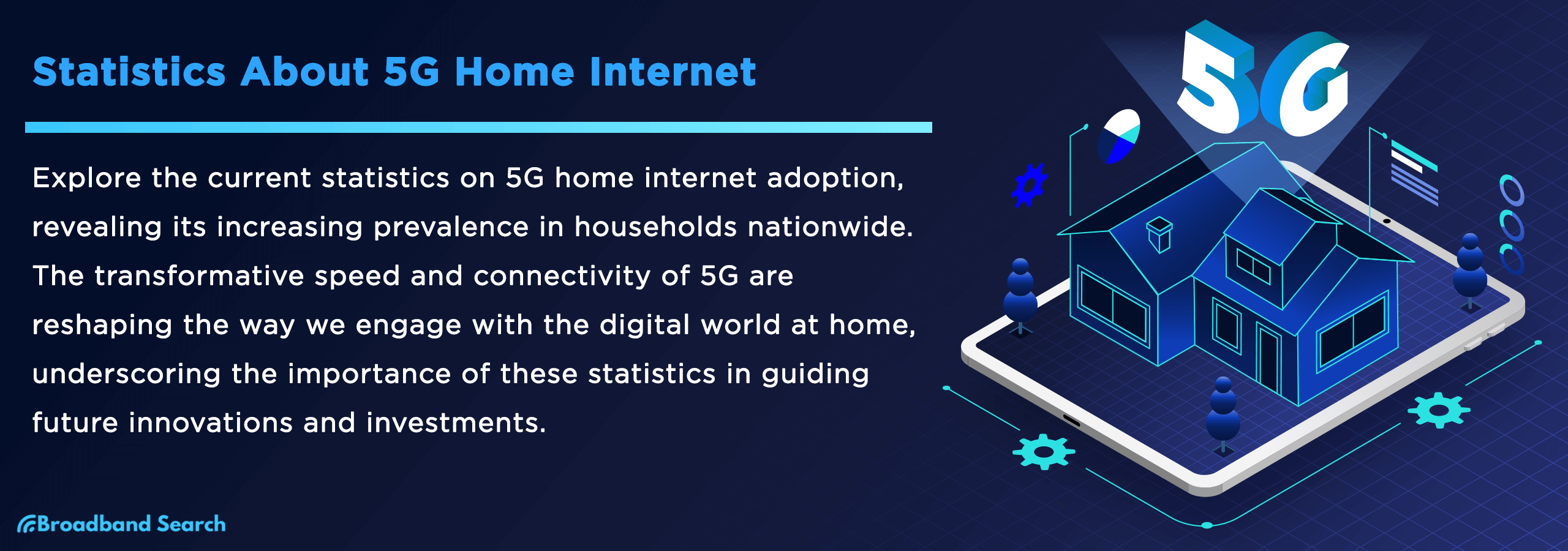5G technology is revolutionizing home internet, offering speeds and connectivity previously unimaginable. This leap forward isn't just about faster browsing; it's transforming how we interact with the digital world from the comfort of our homes. Understanding the statistics behind this technology is crucial. These figures not only demonstrate the capabilities of 5G but also guide future innovations and investments.
As you explore these stats, consider how 5G could change your online experience, enhancing everything from streaming to smart home functionality. This isn't just data; it's a glimpse into a connected future shaped by 5G.
5G Adoption and Penetration Rates
5G, the latest advancement in wireless communication, is rapidly transforming the digital landscape. This technology's swift embrace across the globe reflects its growing influence in various markets, enhancing mobile connectivity and revolutionizing home internet.
United States
As of the third quarter of 2023, the adoption and penetration of 5G home internet in the United States have shown significant growth. North America, including the U.S., had reached 176 million total connections, translating to a 47% penetration rate of 5G internet. This was a result of adding 22 million new connections in just the last quarter of 2023, marking a 14% growth compared to the previous quarter.
Fixed Wireless Access (FWA) 5G home internet, alongside satellite internet, is increasingly becoming a significant player in the broadband industry. This technology is challenging the traditional broadband services provided by cable TV and telephone companies. The change is driven by new competitors entering the market, offering innovative solutions that appeal to customers' desire for the latest technology.
5G Forecast Adoption Rate in North America
The revised forecasts for 5G adoption in North America from 2019-2025, considering the impact of the COVID-19 pandemic, show a notable trend. Initially, there was a slowdown, but from 2023, the adoption rate is expected to surpass previous expectations. Here's a brief overview of the projected versus actual numbers (in millions of connections):
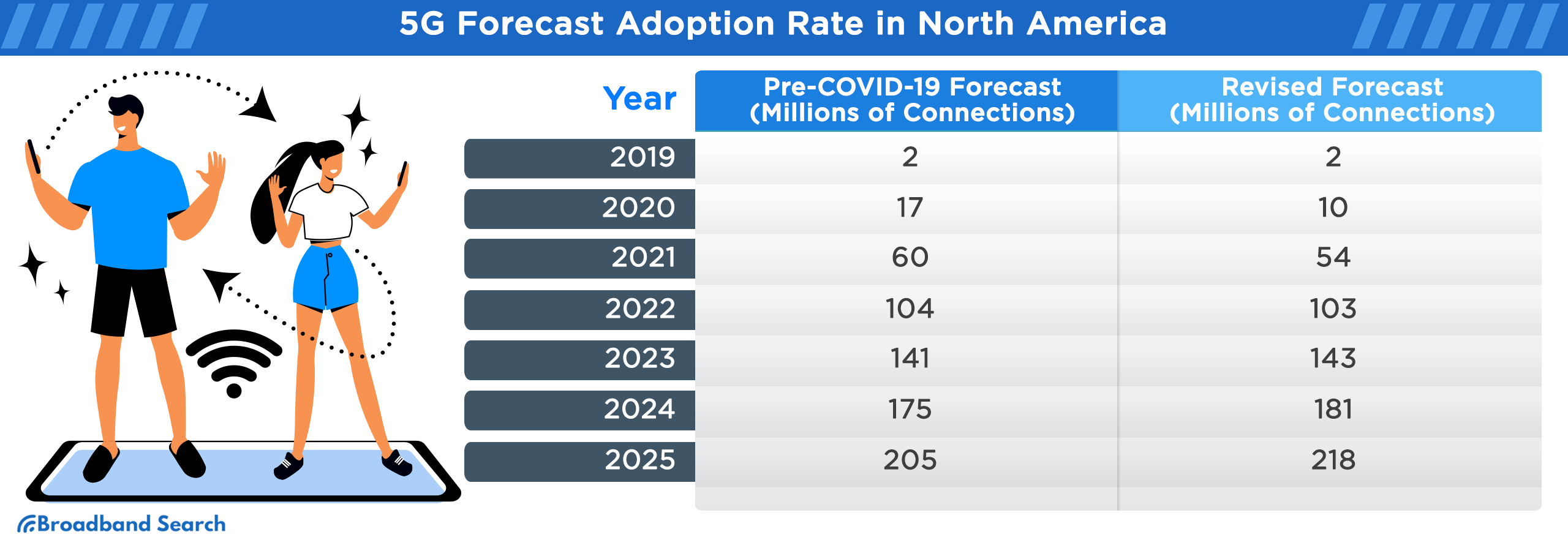
Global Perspective
The global penetration of the 5G market from 2020 to 2030 is projected to show a significant upward trend:
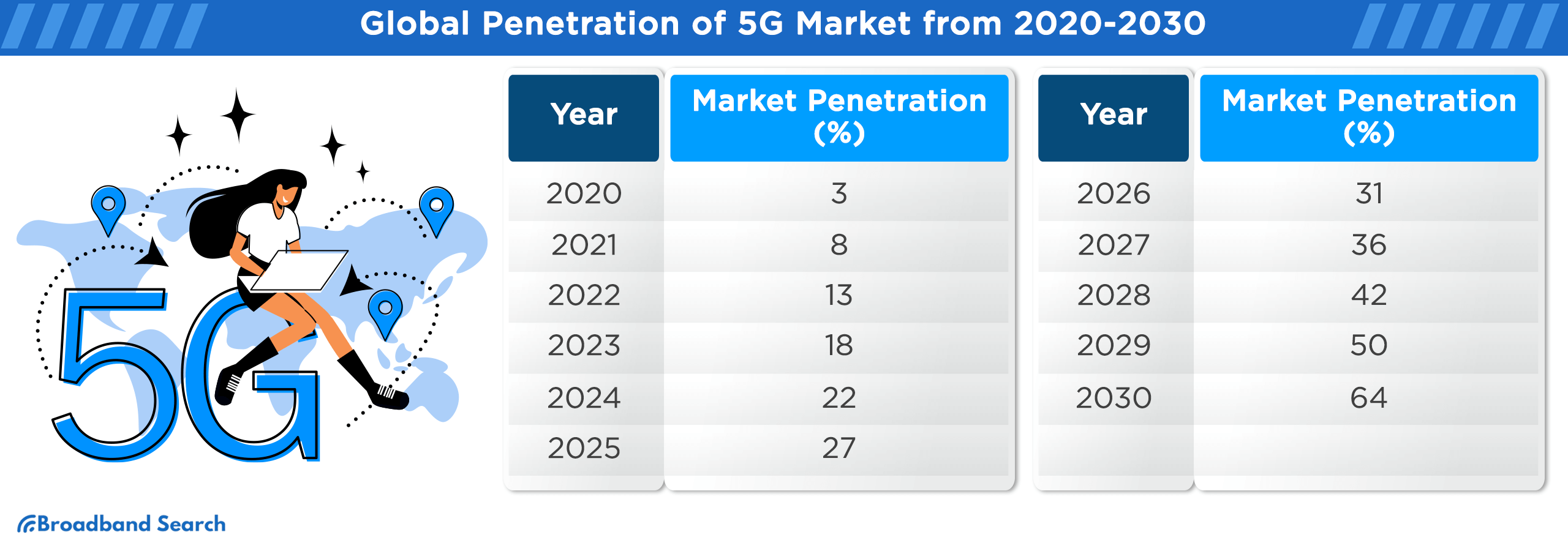
This data reflects the rapidly growing adoption and expansion of 5G technology globally, indicating its increasing significance in the telecommunications sector.
5G Deployment in Different Regions
Across the globe, various regions are witnessing the rollout of 5G technology, each at its own pace and scale. From the bustling cities of North America to the emerging markets in Africa, the implementation of 5G networks is transforming the way we connect and interact with the world.
North America
- United States: Verizon, AT&T, T-Mobile, and smaller companies offer mobile 5G. Verizon provides 5G fixed wireless broadband.
- Canada: Rogers Communications, Telus Mobility, and Videotron are rolling out 5G, covering various cities and communities.
- Mexico: América Móvil and its subsidiary Telcel launched 5G services in major cities.
- Puerto Rico: Claro tested 5G networks.
- Dominican Republic: Altice and Claro are expanding 5G coverage.
- The Bahamas: Plans for 5G are underway but not yet concrete.
Central America
- Honduras: Tigo is modernizing its network for 5G readiness.
- Costa Rica: Grupo ICE supports 5G development, with no clear rollout date.
- Guatemala: Tigo Guatemala initiated the country's first 5G network.
South America
- Chile, Brazil, Colombia, Paraguay, Bolivia: Various providers like Entel, Vivo, Claro, and Tigo are introducing 5G services in key locations.
- Argentina: Movistar has tested 5G but no active network yet.
- Aruba: SETAR and Nokia partnership brought 5G to the island.
Asia
- South Korea, Japan, China, Taiwan, Singapore, India, Indonesia, Brunei, Turkey, Georgia, Vietnam, Iran, Israel, Jordan, Thailand, Nepal, Malaysia, Pakistan, Bangladesh, Bhutan: Rapid 5G deployment by leading telecom companies like SK Telecom, NTT DOCOMO, China Mobile, Chunghwa Telecom, and others.
- Qatar, Kuwait, United Arab Emirates, Oman: Widespread 5G availability through providers like Ooredoo, Zain, Etisalat, STC.
Europe
- Widespread Coverage: Many European countries, including Germany, the UK, Italy, Switzerland, Spain, Austria, Finland, Russia, Norway, have active 5G networks through major providers like Deutsche Telekom, EE, Vodafone, Swisscom, Telefónica, and others.
Africa
- South Africa, Nigeria, Senegal, Egypt, Morocco, Angola, Tunisia, Kenya, Tanzania, Madagascar, Mozambique, Uganda, Ethiopia, Lesotho, Togo, Zimbabwe, Botswana: Progressive 5G rollout in major cities and regions by providers like Vodacom, MTN, Orange, and others.
Oceania
- Australia, New Zealand, Guam, Fiji: Optus, Telstra, Vodafone, Spark NZ, and others are enhancing 5G coverage in major cities and selected regions.
Projected Regional Trends in 5G Mobile Connection Share
The forecast for 5G's share of total mobile connections by region indicates varying levels of adoption across the globe:
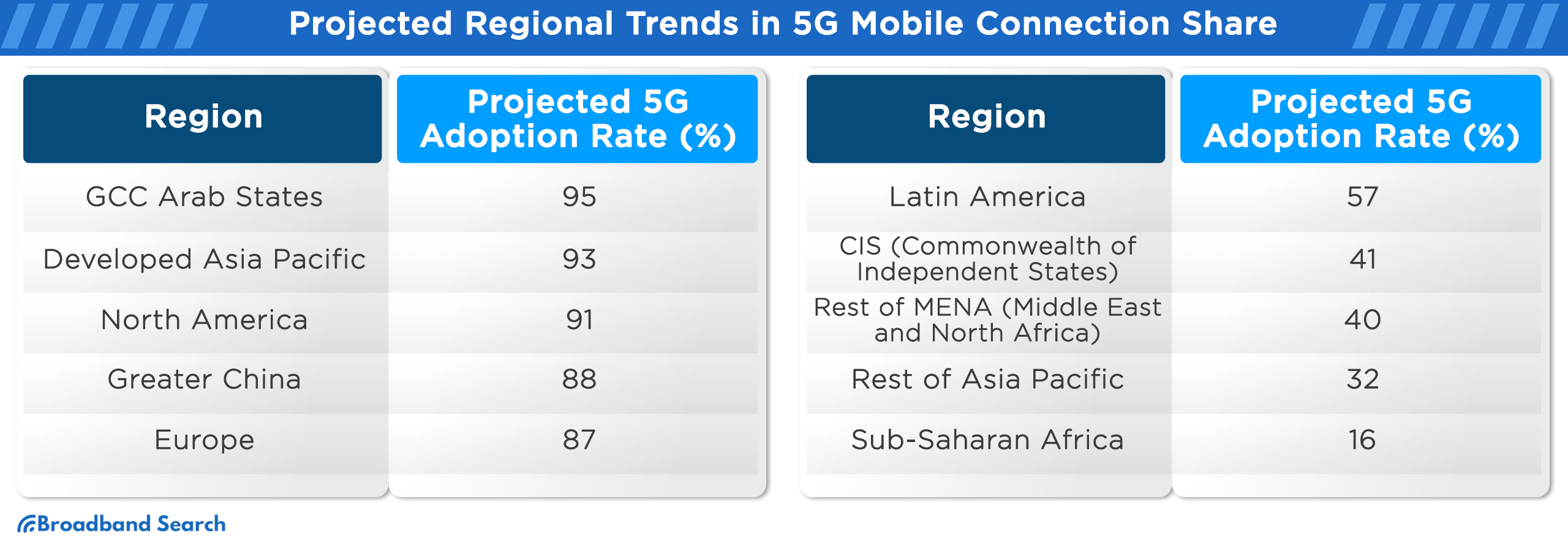
Global 5G City Coverage in 2023 by Country
As of 2023, the availability of 5G in cities across various countries is as follows:
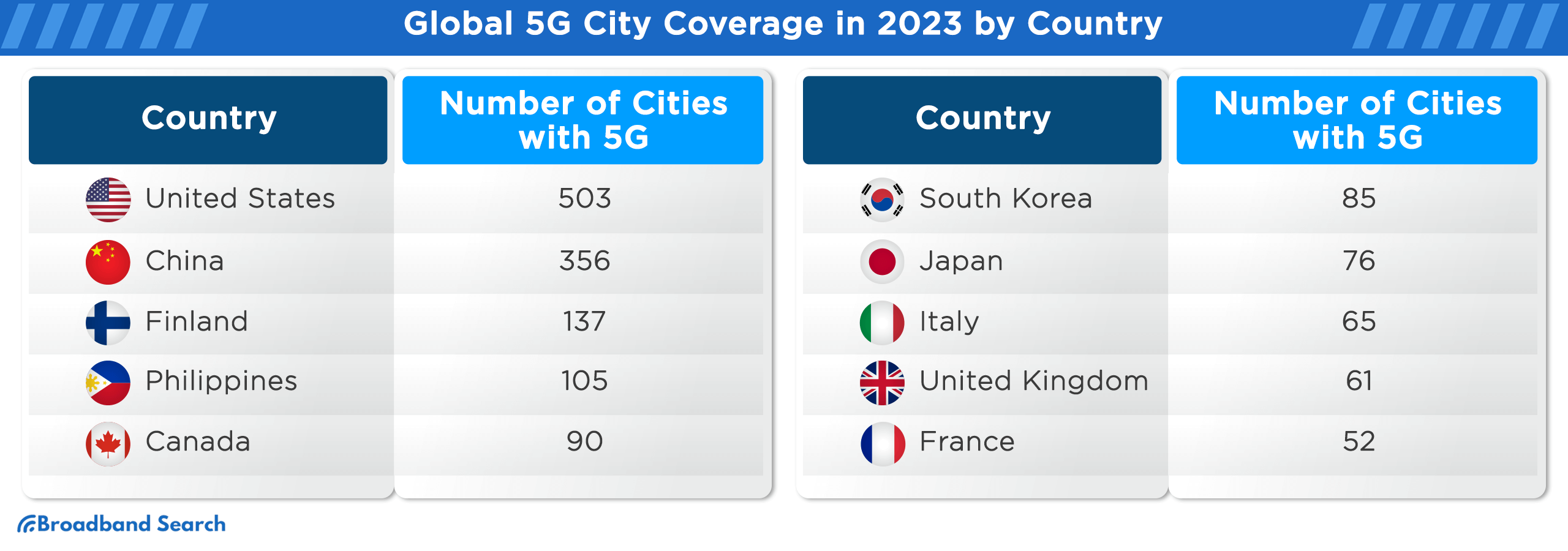
Demographic Insights and User Behavior and Preferences
Statistics on the Demographics of 5G Internet Users
As reported by the GSA in April 2023, the count of 5G devices available commercially has reached 1,513, accounting for nearly 80% of all announced 5G devices. This marks a significant 51.3% growth in available 5G devices since March 2022. The consistent rise in the number of 5G devices since the beginning of the year indicates a trend that is likely to persist, with an expected further increase as more devices enter the market.
In 2022, 4G technology dominated mobile connections, representing 60 percent of all connections, a slight increase from 58 percent in the previous year. Meanwhile, 5G technology held a 12 percent share of the market. Looking ahead, it's anticipated that by 2030, 5G adoption will continue to escalate, ultimately constituting over half of all global mobile connections.
Exploring the diversity within the user base of 5G, recent statistics reveal intriguing patterns across different demographics, highlighting the varying perceptions and willingness to invest in this technology:
- Widespread Willingness to Invest in 5G: Consumers, on average, display openness towards paying an additional $15 monthly for 5G, over and above their current telephone plan costs.
- Rising 5G Awareness in Rural Areas: There has been a notable 27-point increase in 5G awareness among rural consumers over an 18-month period, with awareness levels now at 76%. This rise brings rural awareness in line with urban (79%) and suburban (78%) areas.
- Varied Awareness Across Demographics: The highest awareness of 5G is found among men aged 30-39 at 89%, while the lowest is observed among women aged 60-64, at 64%.
- Consumer Beliefs About 5G Availability: Approximately 30% of consumers believe that 5G is already accessible to them, while 40% are uncertain about the timeline of its availability.
- General Willingness to Pay More for 5G: Half of the consumers indicate a willingness to pay more for 5G services, suggesting a significant interest in the benefits and advancements offered by this technology.
Age Group Trends in 5G Network Access: 2021 vs. 2022
This table highlights the significant increase in 5G network access across various age groups, showcasing a particularly sharp rise in the Gen Z demographic and among those aged over 55.

Gender and Age Influence on Willingness to Pay for 5G Services
The table below shows the greater inclination of men under 40 to invest in these advanced services, in contrast to women over 30 who generally show less willingness to bear additional costs for 5G.

Rural and Urban 5G Connectivity in the United States
This overview presents the dynamic landscape of 5G network availability across rural and urban areas in the United States. The data, spanning from the fourth quarter of 2021 to the second quarter of 2023, illustrates a clear trend of increasing 5G penetration. It reveals a gradual but consistent expansion of 5G network coverage, reflecting the technology's growing footprint in both densely populated urban centers and more sparsely populated rural regions.
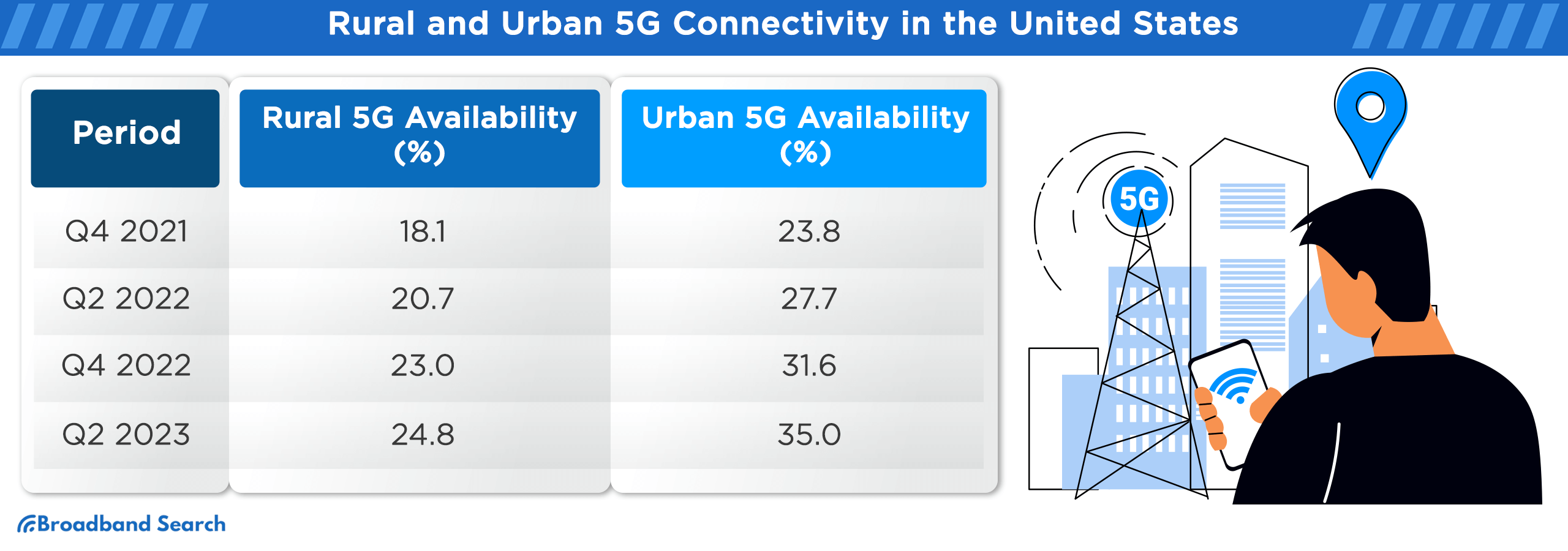
Analysis of User Behavior and Preferences in 5G Connectivity
- Mobile Subscription: The global count of 5G mobile subscriptions is approximately 1.9 billion. Projections indicate a substantial growth, with estimates of 2.8 billion subscriptions by 2024 and 5.9 billion by 2027. 5G networks, known for their higher download speeds and lower latency, offer significant improvements over the preceding 4G networks. This ongoing expansion reflects the increasing global adoption and capabilities of 5G technology.
- Demand for Enhanced 5G Apps and Experiences: Over half (53%) of 5G smartphone users are actively seeking apps and experiences that leverage the network's advanced capabilities. There's a noted 26% of users expressing disappointment due to the scarcity of innovative 5G-specific apps and services.
- Shifting Priorities in 5G Usage: In regions with widespread 5G coverage, users are increasingly prioritizing video quality and upload speeds in their apps, while new adopters focus on basic coverage and speed. This shift reflects evolving user expectations as 5G technology becomes more prevalent, particularly in the US where there's a surge in 5G usage for HD video streaming and AR applications.
- Willingness to Pay Premium: Around 20% of smartphone users are seeking advanced 5G connectivity, valuing and willing to pay a premium of up to 11% for a 5G plan that guarantees superior network performance. This highlights a consumer segment that prioritizes quality in their connectivity experience.
- Regional Diversity in 5G Usage: 5G users, especially in India, are more advanced in their usage compared to users in mature markets, engaging more in enhanced video streaming, HD video calling, gaming, esports, and AR. A significant portion of these advanced 5G users are in major Indian cities like Delhi, Mumbai, and Bangalore, leading to higher mobile data consumption.
- 5G Fixed Wireless Access: The global adoption of 5G FWA connections is showing a rapid growth trajectory from 2020 to 2028.

5G Home Internet Trends
Emerging trends in 5G home internet usage in 2024 indicate a transformative phase in internet connectivity, largely driven by the rollout of 5G technology and the integration of smart devices and Internet of Things (IoT). These developments are reshaping not just the speed but also the way we experience and interact with the internet.
One of the key trends is the growing influence of IoT, which is revolutionizing digital interactions. The surge in smart devices that communicate with each other is creating an intricate web of connectivity, enhancing efficiency, convenience, and personalization in daily life. This includes smart homes and wearable devices that are increasingly integrated into our routines.
With 4G, the average latency hovers around 200 milliseconds, comparable to the time it takes for a human to react to visual cues. In contrast, 5G dramatically reduces this latency to a mere 1 millisecond. This significant reduction is crucial for the development of innovative services and devices. For instance, in the realm of connected vehicles, latency determines the time lapse between a "stop" command and the actual braking of a remotely controlled car. It's this low latency that makes Vehicle-to-Everything services feasible.
It is also anticipated that connected cars will constitute the largest segment of the 5G IoT endpoint installed base worldwide, with projections of over 19 million installed endpoints. This reflects the increasing integration of 5G technology in the automotive industry, enhancing vehicle connectivity and smart features.
Additional Emerging Trends
These trends not only reflect the dynamic nature of consumer behavior but also highlight the innovative strides being made in 5G telecommunications and digital services.
- Use of 5G Home Internet Services: A majority of home internet users, about 70%, have maintained the same internet service over the past year, with high satisfaction levels similar to those recorded in 2022. Also, approximately 27% of users are contemplating a switch to 5G home internet, with 14% showing interest in combined 5G FWA-mobile bundles.
- Rise in Fixed Wireless Access Usage: By the end of 2029, worldwide FWA connections are projected to rise to 330 million, a significant increase from 130 million in 2023. This growth means that FWA will represent 18% of all fixed broadband connections, with nearly 85% of these expected to be over 5G. The Asia-Pacific region, in particular, will see its share of global FWA connections grow from 38% to 46%, indicating a more than threefold increase.
- High Likelihood of Provider Switch for 5G: About 50% of respondents indicated their willingness to switch to a different service provider if their current one doesn’t offer 5G within the next 12 months. The groups most inclined to make the switch include remote workers, video streamers, and home monitors. These users are characterized by high engagement and are expected to substantially utilize 5G capabilities.
- Perception of 5G Connectivity Among Users: Despite over 60 percent 5G population coverage in most markets, only a third (33 percent) of 5G users feel that they are connected to 5G more than half of the time. Among the consumers who perceive a high availability of 5G, a significant majority (70 percent) express satisfaction with their 5G service provider.
Speed and Performance Data
Comparative Analysis of 5G vs 5G Home Internet Speeds
For a network to qualify as 5G, it must meet specific standards set by regulatory bodies like the 3rd Generation Partnership Project (3GPP). Among these criteria are the minimum required speeds for both uploads and downloads.
A network must achieve certain peak download and upload rates to be officially designated as a 5G network. Specifically, each 5G base station is required to support the following speeds:
- The peak download speed for 5G is set at 20 gigabits per second (Gb/s), equivalent to 20,480 megabits per second (Mb/s).
- The peak upload speed for 5G is defined as 10 gigabits per second (Gb/s), or 10,240 megabits per second (Mb/s).
5G deployment is ongoing nationwide, and as a result, the availability of 5G home internet services is still somewhat limited. The providers that do offer 5G home internet typically deliver speeds ranging from 50 Mbps to 1,000 Mbps. Compared to 4G, 5G offers significantly enhanced performance, capable of achieving peak data rates up to 20 Gbps and average data rates exceeding 100 Mbps. This substantial increase in speed and efficiency highlights the advanced capabilities of 5G technology over its predecessor.
However, the real-world speeds experienced on a 5G network are influenced by a variety of factors. These include your geographical location when using the network, the capabilities of the hardware you're using, the network's maximum achievable speeds, the number of users sharing the network capacity of over 20 Gb/s, and any potential interference that might exist between your device and the 5G cell tower.
User Experience and Reliability Statistics
The global 5G experience has shown a marked improvement over 4G, especially in terms of speed and user experience enhancements in mobile video streaming and gaming.
- Leaders in 5G Availability Globally: South Korea and Puerto Rico lead globally in 5G availability, with users in these markets spending a substantial portion of time on 5G networks. The U.S. also ranks highly due to widespread low-frequency band usage and standalone 5G deployments.
- 5G Speed Variations Across the U.S.: Illinois topped the list of U.S. states in terms of average 5G download speeds at a national level, achieving 141.4 Mbps. New York and Minnesota were close contenders, recording average 5G download speeds of 138.6 Mbps and 131.9 Mbps, respectively. On the other end of the spectrum, Vermont had the lowest average 5G download speed at 48.7 Mbps.
- Global Increase in 5G Download Speeds: In the third quarter of 2023, the median global 5G download speed saw a significant rise of 20%, reaching 203.04 Mbps, up from 168.27 Mbps in the same quarter of the previous year. This increase is in line with the substantial growth in global 5G subscriptions, reflecting an upward trend in both the adoption of 5G technology by users and the enhanced performance of 5G networks.
- Verizon's 5G Reliability Leadership in the U.S.: Maintaining its top position, Verizon has been recognized for the fifth consecutive time for delivering the most reliable 5G experience in the US. It achieved the highest success rates in 112 out of 125 markets, surpassing both AT&T (63 markets) and T-Mobile (25 markets) in terms of 5G connectivity and stability. This makes Verizon a strong contender for users seeking dependable 5G network performance.
- U.S. 5G Experience: T-Mobile leads in both 5G availability and reach in the United States, thanks to its extensive nationwide coverage. However, the overall 5G experience varies among different carriers, with each excelling in different areas such as video and gaming experience.
Data on Peak Performance and Average Speeds
These figures indicate that T-Mobile is leading in both download and upload speeds, followed by AT&T and Verizon, which show similar performance in download speeds. For upload speeds, AT&T outperforms Verizon. This data is essential for users considering the most efficient carrier for their needs, particularly in scenarios requiring high data transfer rates, such as streaming, gaming, and large file uploads.
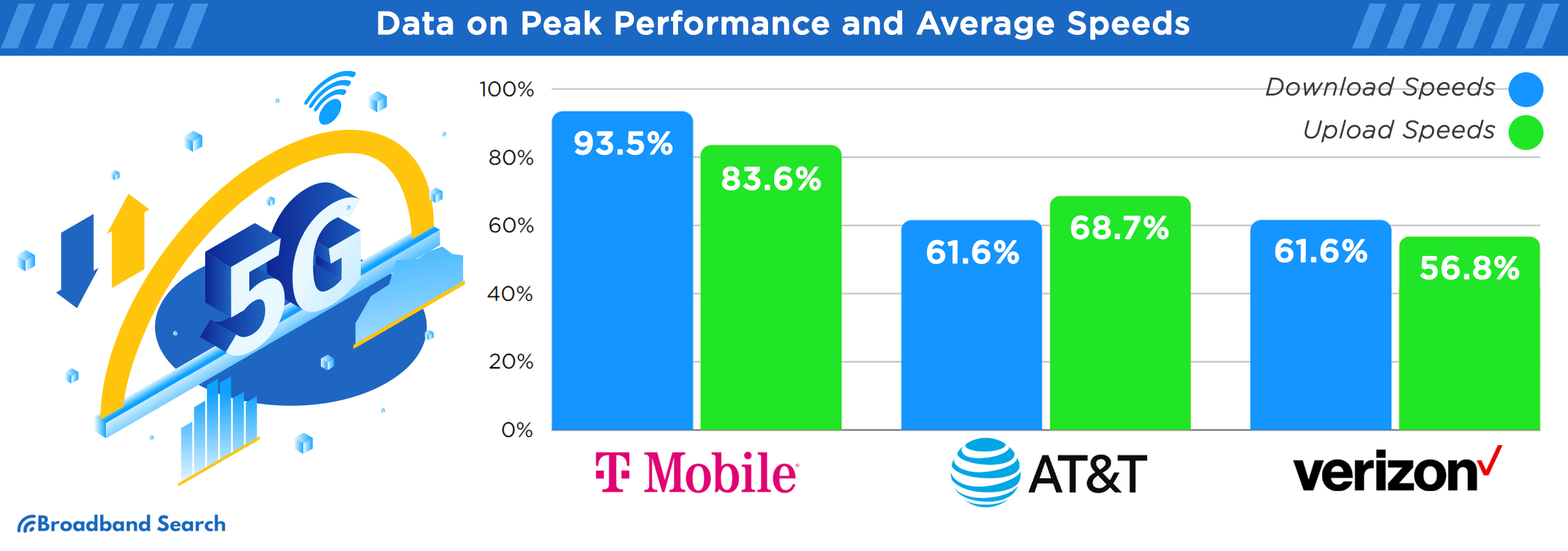
Coverage and Availability of 5G Home Internet in the US
Before exploring 5G home internet options, it's crucial to check if you're within a provider's coverage area. While coverage varies among ISPs, T-Mobile boasts the most extensive and widespread 5G network in the U.S., making it a strong contender for 5G home internet.
Current State of 5G Network Coverage in the US
As of 2024, the landscape of 5G network coverage in the US reflects significant progress and variation across different carriers. Verizon, known for its extensive cellular network, offers both fixed and mobile 5G, covering approximately 12.7% of the country. Its 5G network utilizes both the mmWave and Sub-6 spectrum, with the mmWave network being more limited in range but offering higher speeds where available.
AT&T boasts a more widespread 5G network, with coverage in all 50 states and accounting for about 29% of the nation. However, the speeds and type of 5G connectivity provided by AT&T vary by location, largely depending on the Sub-6 spectrum. AT&T also offers mmWave (referred to as 5G+) in certain major cities, although this is more limited in scope.
T-Mobile leads in terms of 5G coverage, with a nationwide network that primarily relies on the Sub-6 spectrum, resulting in broader but slower coverage compared to mmWave networks. T-Mobile's coverage extends to more than 9,000 zip codes across over 3,000 cities, accounting for about 53.79% of the nation. The carrier's strategy includes building out Sub-6 5G on the same towers as its 4G network, which has facilitated its extensive reach.
In addition to mobile 5G, there is also a growing presence of 5G home internet services. These services, provided by carriers such as T-Mobile and Verizon, use 5G technology to deliver home internet connectivity wirelessly, although their performance in terms of speed and latency is still evolving when compared to traditional fiber or cable services.
Regional Disparities and Expansion Plans
Since its commercial rollout in 2019, 5G mobile network coverage has expanded significantly, now encompassing nearly 40% of the global population. However, this distribution is notably uneven. In high-income countries, about 89% of the population has access to 5G networks, whereas in low-income countries, 5G is scarcely available.
For many of these low-income regions, 3G remains the primary means of internet access, which limits the full utilization of digital technology benefits. While 4G offers a more meaningful connectivity option, it only reaches 39% of people in these low-income areas.
Challenges in Rural and Urban 5G Deployment
To effectively implement 5G in rural areas, several key issues must be tackled. Infrastructure expansion in these regions calls for considerable investment, necessitating a partnership between government and private sector entities. Additionally, crafting regulatory frameworks that support investment, promote competitive fairness, and provide rural communities with affordable 5G access is crucial.
Enhancing digital literacy in these areas is also important, enabling residents to utilize the advantages of 5G technology to their fullest. Addressing these challenges is critical to the successful integration of 5G in rural environments.
Technological Developments
Recent technological advancements in 5G are shaping a new landscape for mobile and home internet connectivity. Key trends in 2024 include:
- Open RAN (O-RAN): This is a transformative approach in 5G technology, emphasizing open and interoperable radio access networks. It fosters innovation, diversity in vendors, and allows for more flexible and scalable network infrastructures. O-RAN supports advanced concepts like network slicing and virtualization, enabling operators to tailor virtual networks for specific applications like IoT and high-speed broadband.
- Network Slicing: This technology allows for the creation of multiple virtual networks over a shared physical infrastructure. It's pivotal in meeting the diverse demands of 5G applications by enabling ultra-reliable, low-latency connections and massive machine-to-machine communications.
- Beamforming: This method improves signal strength and reduces interference by focusing the wireless signal towards a specific receiving device. It's particularly beneficial in densely populated areas and for efficiently using the available spectrum.
- Standalone 5G Infrastructure: This involves 5G networks that operate independently of 4G LTE networks, using cloud-native principles like virtualization and microservices. It offers more flexibility, scalability, and efficiency in resource use.
Future Projections Stats
Enhancing Real-Time Applications with Edge Computing
Edge Computing represents a significant shift in data processing, bringing computation closer to the location where it is needed. This technology is particularly beneficial for applications that require real-time processing and low latency. Its impact is profound in areas such as:
- Autonomous Vehicles: By processing data closer to the source, edge computing significantly reduces the response time, which is critical for the safety and efficiency of autonomous vehicles.
- Smart Infrastructure: Urban environments can greatly benefit from edge computing through improved traffic management, energy distribution, and public safety systems. It enables real-time analysis and decision-making, leading to smarter and more responsive cities.
Quantum Internet for Secure Communications
The Quantum Internet, still in its early stages, is anticipated to revolutionize how we secure our digital communications. Its potential applications include:
- Data Encryption: Leveraging the principles of quantum mechanics, this technology could offer a new level of security, making it nearly impossible for hackers to intercept or decipher communications.
- Secure Transactions: In the financial sector, quantum internet could provide a highly secure platform for transactions, protecting against fraud and cyber threats.
Satellite Internet: Bridging the Global Connectivity Gap
Satellite Internet is an emerging solution aimed at providing worldwide internet coverage, especially focusing on:
- Global Internet Access: Companies like SpaceX and Amazon are leading initiatives to deliver internet connectivity globally, which is especially crucial for remote and underserved areas.
- Impact on Education and Commerce: This technology has the potential to democratize access to information and digital services, thus fostering educational and economic opportunities in previously disconnected regions.
6G Technology and Its Future Impact
- The Emergence of 6G: 6G promises to surpass the capabilities of 5G, offering even faster data transmission speeds and lower latency. This advancement could lead to groundbreaking innovations in various fields, including virtual reality, autonomous vehicles, and more advanced IoT (Internet of Things) applications.
- Potential Implications of 6G: The advent of 6G technology is expected to bring transformative changes across multiple sectors. For instance, in the realm of communication, 6G could enable more immersive AR (Augmented Reality) and VR (Virtual Reality) experiences, providing real-time interactions that are almost indistinguishable from reality.
5G's Role in Manufacturing and Economic Impact
- Surge in 5G Manufacturing Demand: The integration of analytics, AI, and robotics in manufacturing has led to a substantial increase in demand for 5G technology. With 5G, manufacturing processes can be optimized, leading to enhanced productivity and reduced operational costs. This technology enables real-time data analysis and decision-making, significantly improving production quality and efficiency.
- Economic Impact of 5G in Manufacturing: According to a McKinsey report, the impact of enhanced connectivity in manufacturing, primarily driven by 5G adoption, could significantly boost the global GDP. The estimated increase ranges between $400 billion to $650 billion by the end of the decade. This economic uplift is attributed to the increased efficiency and productivity in manufacturing processes enabled by 5G.
Transformation of Healthcare Through 5G
- 5G's Role in Revolutionizing Healthcare: 5G technology is set to revolutionize the healthcare sector by enhancing various aspects, from supply chain management to remote diagnostics and patient care. With 5G, healthcare providers can access and share medical data more quickly and reliably, leading to improved diagnosis and treatment outcomes.
- New Healthcare Ecosystem: The integration of 5G in healthcare is shaping a new ecosystem aligned with 4P medicine—predictive, preventative, personalized, participatory. This transformation promises enhanced connectivity, meeting patient and provider needs effectively. However, ensuring network security and data privacy is crucial for its success.
The Bottom Line
5G home internet is poised to revolutionize our digital connectivity. It's not just about faster speeds and enhanced network reliability; this technology is set to transform the way we interact with the internet at home. It brings the promise of reshaping our experiences with smart home technologies and a myriad of connected devices, leading to a more seamlessly integrated digital life.
The ongoing development of 5G highlights the importance of ongoing research and analysis. As this technology evolves, comprehending its impacts, advantages, and potential challenges is essential. This understanding is crucial for steering future advancements and ensuring that the full benefits of 5G, in terms of global connectivity and beyond, are fully leveraged.
FAQ
What is 5G home internet?
5G home internet refers to a type of internet service that utilizes the fifth-generation technology standard for cellular networks. This service provides high-speed internet by capitalizing on the capabilities of 5G networks. These networks are known for their faster data transmission speeds and reduced latency, offering a significant improvement over the earlier 4G networks. As a result, 5G home internet users can enjoy quicker download and upload speeds, as well as more responsive internet experiences, suitable for a wide range of online activities.
Does weather affect 5G home internet performance?
Yes, weather can affect 5G home internet performance, particularly in systems that use higher frequency bands like millimeter wave (mmWave). 5G networks operating on these higher frequencies can be impacted by atmospheric conditions such as heavy rain, dense fog, or extreme cold. These weather conditions can attenuate or absorb the radio waves, potentially leading to reduced signal strength and quality.
Are there data caps on 5G home internet plans?
As of the current time, major providers such as AT&T, T-Mobile, and Verizon offer 5G home internet plans without data caps. This means users can enjoy high-speed internet without worrying about exceeding data limits, which is beneficial for activities that consume a lot of data, like high-definition streaming, online gaming, and extensive downloading.
How does 5G home internet impact online gaming or streaming?
5G home internet positively impacts online gaming and streaming by offering higher speeds and reduced latency. For gamers, this means significantly less lag, ensuring more responsive and seamless gameplay. In terms of streaming, users experience smoother video playback with less buffering, thanks to faster data transmission. The overall result is an enhanced and more enjoyable online experience, whether you're engaging in competitive gaming or streaming your favorite shows in high definition.
How does 5G home internet contribute to IoT (Internet of Things)?
5G home internet plays a pivotal role in advancing the Internet of Things (IoT) by offering faster and more reliable connections for a wide array of devices. The key advantage of 5G in the context of IoT lies in its capacity to support a larger number of devices concurrently, coupled with significantly lower latency. The implementation of 5G thus facilitates a more interconnected and efficient IoT environment, driving innovation and functionality in smart homes and other IoT applications.

